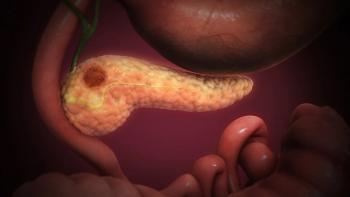
- ONCOLOGY Vol 10 No 9
- Volume 10
- Issue 9
Supportive Nutritional Management of the Patient With Pancreatic
Progressive weight loss and nutritional deterioration are commonly found in the patient with pancreatic cancer. The combined effects of the central anatomic location of the pancreas,
ABSTRACT: Progressive weight loss and nutritional deteriorationare commonly found in the patient with pancreatic cancer. Thecombined effects of the central anatomic location of the pancreas,endocrine and exocrine hormonal insufficiency, and treatment toxicityplace patients with pancreatic cancer at high risk for developingsymptoms that affect their ability to consume and absorb adequatecalories and protein. The use of standardized nutritional assessmentand an algorithmic approach for nutritional intervention fostersdetermination of the patient's nutritional risk status early inthe course of disease, fosters early detection of treatable symptomsthat interfere with nutritional intake/absorption, and can assessthe effect of nutritional interventions. Supportive nutritionalefforts can decrease complications, shorten hospital stays, reducecosts, and improve the patient's sense of well-being. [ONCOLOGY10(Suppl):26-32, 1996]
Definition of standardized assessment tools and interventionshas been the backbone of protocol treatment in the context ofthe national cooperative oncology groups. In a similar manner,an algorithm of standardized nutritional assessment and interventionin the oncology patient has been developed and is increasinglybeing used as a guide to supportive nutrition in patients withcancer (Figure 1).
The proactive approach to nutritional care as defined by the algorithmis particularly important in patients with pancreatic cancer.These patients are at high risk for nutritional problems, basedon the combined effects of the central anatomic location of thepancreas, endocrine and exocrine hormonal insufficiency, and treatmenttoxicity of multimodality therapy. When symptoms that affect nutrition(eg, anorexia or fat malabsorption) or significant weight lossare present at the time of diagnosis, the risk of progressivenutritional deterioration is further increased.
Because the onset of pancreatic cancer is insidious (delayingthe presentation of the patient for diagnosis and treatment) andsince weight loss is often progressive and may be rapid and severe,all factors that contribute to anorexia and other nutritionalimpact symptoms need to be assessed promptly and interventionsinitiated expeditiously. Extreme weight loss and malnutritionare important contributors to morbidity and mortality in patientswith cancer and negatively impact response to antineoplastic therapy[1].
The goals of nutritional care are to support adequate caloricand nutrient intake, body composition, functional or performancestatus, immune function, and quality of life [2]. A proactivenutritional approach in the care of oncology patients was outlinedby Shils in 1979 in the principles of nutritional care in thecancer patient [3]. Early detection of nutritional problems andprompt intervention are essential for success, whether the aimof treatment is cure or palliation. Once a patient's nutritionalstatus has deteriorated to the point of severe depletion, attemptsto reverse the condition rarely succeed, especially in the faceof severe muscle wasting.
The primary cause of clinically evident nutritional deteriorationin the patient with pancreatic cancer is inadequate intake andabsorption of calories and protein. Examples of nutritional impactsymptoms commonly noted in this patient population include earlysatiety, anorexia, fat malabsorption with crampy abdominal painand bloating, nausea and/or vomiting, diarrhea or constipation,pain, and fatigue. These symptoms are treatable, but they requireearly detection and aggressive management. The pervasiveness ofnutritional challenges in the patient with pancreatic cancer necessitatesthe use of standardized nutritional assessment tools and promptintervention to optimize outcomes and quality of life for thesepatients.
Malnutrition has a wide range of adverse effects [1, 4-10]. Thegeneral impact of weight loss on outcomes has been known sincethe 1930's [11] and has been confirmed in a number of subsequentstudies [9]. Malnutrition is associated with adverse outcomeson a number of levels and contributes to higher health-care costsand prolonged hospitalizations [4, 12-14].Weight loss, nutritionaldeterioration, and inanition can hasten death, reduce responseto treatment, exacerbate treatment toxicities and complications,and adversely affect quality of life in the oncology patient.
Health-Care Outcomes
The incidence of malnutrition in general medical and surgicalpatients reported between 1973 and 1986 ranged from 30% to 50%[15]. Malnutrition increases health care costs and prolongs hospitalstays due to slower wound healing and increased incidence of complications[16-19]; it also increases mortality [11,13,14,20-22].
It has been estimated that 20% to 40% of patients with cancerdie from the effects of malnutrition and its complications, asopposed to the malignancy per se [23]. Significant weight lossis a major prognostic indicator in patients with cancer in termsof response to treatment and overall survival [1]. Weight loss,malnutrition, or failure to thrive are the most commonly listedcauses of death in cancer patients [7,8,24].
Criteria for grading of treatment-related toxicity are standardizedand included in all oncology protocols. Criteria for weight lossare included in Table 1. The current grading of this nutritionaltoxicity, however, is inadequate [2,25,26]. Table 2 includes thestandard definitions of severe and significant weight loss thatare used in the nutrition literature. Significant weight lossis defined as that for which there is a statistically significantincrease in morbidity and mortality. The weight loss toxicitycriteria used in oncology protocols do not take into consideration1) the time interval during which weight loss is experienced or2) total cumulative weight loss, including pretreatment loss.In addition, the basis for the grading of life-threatening (grade4) nutritional toxicity is not defined. Aspects of weight losssuch as acuity and the extent of cumulative loss need to be incorporatedinto current treatment protocols to be consistent with known outcomedata in the nutrition literature.
Quality of Life
Nutritional status affects quality of life in terms of self-image,the patient's ability to perform activities of daily living, andoverall life satisfaction. The ability or desire to eat significantlyaffects a patient's ability to socialize and interact with familyand friends [27,28]. Progressive weight loss causes distress topatients, their families, and the health care team.
With malnutrition and cachexia, muscle weakness and fatigue contributeto depression and may compound difficulties in meal preparationor participation in eating with family or friends [2]. Reducedactivity and bed rest lead to constipation and progressive musclewasting. Progressive fatigue secondary to nutritional deteriorationand inanition (severe muscle wasting) are the primary determinantsaffecting patients' ability to continue working at their jobsor to carry on any aspects of normal life.
Progressive nutritional deterioration in many patients with pancreaticcancer is caused by symptoms that affect food intake and nutrientabsorption. Those symptoms that affect nutrition (anorexia, diarrhea,pain) can, in addition to contributing to weight loss, adverselyaffect quality of life. Weight loss often can be slowed or preventedby directing attention to those aspects which can be treated pharmacologicallyand/or behaviorally [2,23,29-31].
Economic Impact
Few data are available on the economic impact of malnutritionin cancer patients. A significant contribution to health carecosts is the average length of stay (ALOS) in a hospital. Theaverage length of stay is nearly twice as long for malnourishedpatients as it is for patients with the same diagnosis who arewell nourished [4]. Little or no data have been available concerningthe impact of nutritional status in the patient with cancer. Reviewof discharge data from the Fox Chase Cancer Center from 1993 to1994 was carried out to evaluate the affect of nutritional statuson ALOS. The average length of stay for all discharged patientswas 5.8 days, whereas patients with a discharge diagnosis of dehydrationand/or malnutrition had an ALOS of 9.4 days. With a dischargediagnosis of malnutrition alone, the ALOS was 13.4 days [32].The category of malnutrition/dehydration was important to consider,since patients in this category were not eating adequately duringthe 9.4 days and yet such patients often are not identified asbeing at risk of nutritional deficit.
Studies by Robinson et al [5] support the concept of proactivenutritional intervention. In these studies, the majority of increasedhealth care dollars spent for care (approximately two- fold) involvedpatients with borderline malnutrition as compared with well-nourishedpatients. Only a relatively small additional cost was associatedwith managing severe malnutrition, as compared with borderlinemalnutrition.
Assessment
The Patient-Generated Subjective Global Assessment (PG-SGA) ofnutritional status [2,29] (Figure 2) is a standardized instrumentused to assess the patient's nutritional risk or deficit. In addition,its serial use can gauge the success or failure of nutritionalinterventions. The PG-SGA is a modification of an earlier assessmenttool known as the SGA, developed by Jeejeebhoy, Baker, Detsky,and colleagues at the University of Toronto and published in ausable form in 1987 [33-35]. An oncology modification was offeredin 1993 by Ottery, with a later modification developed (the PG-SGA)to be completed by the oncology patient while waiting to be seenduring an oncology outpatient visit.
The use of the original SGA was based on the hypothesis that riskassociated with malnutrition can be minimized or reversed if intaketo meet nutrient requirements is restored. The stage of nutritionalrisk or deficit is based on physiologic status rather than physicalappearance alone. The PG-SGA estimates the nutritional statusof patients with cancer based on weight history, nutritional intake,assessment of symptoms that affect nutrition, and the patient'sself-rated performance status (Zubrod or Eastern Oncology Group[ECOG] status) [36]. The patient is then categorized or stagedinto one of three categories: SGA-A, the well-nourished patient;SGA-B, the patient with moderate or suspected malnutrition; orSGA-C, the patient with severe malnutrition (Table 3).
The oncology modification was developed to include earlier timepoint information than the original SGA and additional symptomspertinent to the oncology patient. To be useful to the oncologyteam, it was decided that a patient-generated format would bemost appropriate. This is due to:
1) The fact that time is often at a premium in a busy oncologypractice
2) The concern on the part of patient and family about progressiveweight loss and the fact that they are frustrated that nutritionis often not addressed in a proactive manner
3) Potential use of the patient waiting time as an appropriateand effective method to globally assess the supportive componentsof patient care.
The sections of the PG-SGA that patients complete are targetedto the sixth- to eighth-grade reading level, and the cliniciancomponent generally adds less than 1 minute to the overall patientassessment time. In addition to the English version presentedhere, there is also a Spanish version, and additional translationsare in development.
Algorithm for Intervention
Once the patient is stratified into one of the three categories,the Algorithm of Optimal Nutritional Intervention (Figure 1) isused to guide intervention. After determination of the patient'sSGA status, the next step in the algorithm is to determine thepatient's risk status based on the proposed antineoplastic therapy.Risk categories relate to the risk of a given treatment to inducenutritional impact symptoms. Nutritionally high-risk cancer therapyis defined as that which is associated with an approximately 30%to 50% risk of grade 3 GI toxicity or febrile reaction. Chemotherapyprotocols that are highly emetogenic or that are part of a multimodalitytreatment regimen would fall into this category. Nutritionallyhigh-risk radiation therapy includes multimodality therapy andfactors such as port location (inclusion of small bowel, laryngealports greater than 7 × 7 cm), and fractionation and totaldose. By categorizing and staging the patient's nutritional risk,earlier intervention is fostered.
As noted in the algorithm, the PG-SGA should be used routinelyin the initial diagnostic period before the treatment plan hasbeen initiated, and also should be employed at specific intervalsduring intervention to serially reassess the patient's nutritionalstatus. The importance of regular reassessment cannot be overstated.The responsible clinician (often the nurse or dietitian) shouldcoordinate reassessment by the PG-SGA with each medical or radiationoncologist visit, so that specific interventional decisions (eg,pharmacologic treatment of nutritional impact symptoms) can beinitiated on the day that the problem is diagnosed. In other patientpopulations, eg, general surgery patients, transition from anSGA-A to an SGA-C is associated with significant increases inboth septic and non-septic complications.
Dotted lines from each point of deterioration in the algorithmdetermine the next level of intervention. The wide dashed linesfrom the Specialized Nutrition Intervention box refer to the pathwaysfor those patients who need to be triaged directly to enteraltube feedings or parenteral nutrition rather than attempt theoral route. The thinner dashed line leading from the box for unsuccessfulenteral support does not mean that parenteral nutrition is theonly option, but implies that if changes in the enteral regimenare not successful, parenteral nutrition is an option that shouldbe considered in the patient who continues to undergo antineoplastictherapy.
Based on the results of the PG-SGA and the initiation of the algorithm,intervention may range from the use of patient education materialsto the initiation of supportive nutrition [29]. The options forsupportive nutrition include oral intervention with aggressivesymptom management [2,29-31], and enteral or parenteral nutrition.
Supportive nutrition requires a comprehensive, interdisciplinaryapproach, including the services of nurses, social workers, dietitians,surgeons, and oncologists. Nursing staff may, depending on thesetting, serve as the primary source for triaging the patients'needs in terms of symptom management and nutritional risk. Theymay also serve as the primary educational resource if a dietitianis unavailable or at the second level of intervention. Depression,employment and financial issues, as well as family concerns anddynamics, may play an important role in the ability to meet theneeds for supportive nutritional intervention. Involvement ofsocial workers may be important in the implementation of the nutritionalintervention plans. The surgeon or surgical oncologist needs toconsider the patient's entire course--addressing the need formaintenance of preoperative nutritional status during neoadjuvanttherapy as well as consistently addressing the placement of afeeding tube as part of any surgical procedure in a patient whowill be placed on a nutritionally high-risk oncology regimen postoperatively.In addition, since even 1 week of bedrest is associated with a4% loss in muscle mass [37,38], incorporation of a home exerciseprogram into the treatment plan can facilitate the conversionof caloric and protein intake into muscle mass and prevent furtherloss of muscular function.
In addition to the almost universal finding of significant weightloss, many of the other signs and symptoms of pancreatic cancerreflect the disease's nutritional impact. Table 4 lists the clinicalfeatures of pancreatic cancer by site of occurrence.
Nutritional Impact Signs and Symptoms: Anorexia and Malabsorption
Weight loss and anorexia are major clinical features of pancreaticcancer. Indeed, the extent of malnutrition in patients with pancreaticcancer is primarily related to malabsorption and anorexia. Whilefat malabsorption is a well-known complication of pancreatic cancerand its treatment, clinicians frequently underdiagnose and undertreatthis syndrome. While clinical tests, such as fecal fat determination,are available for diagnosis, talking to the patient and familyare most important. The onset of "stinky stools" sincediagnosis or surgery, as well as crampy abdominal pain and bloating,are nearly pathognomonic in this patient population for fat malabsorption.While the presence of diarrhea and/or oily stools certainly arehelpful in the diagnosis, patients may not have this classic complaintand, in fact, may have constipation due to a narcotic analgesicregimen.
Treatment of fat malabsorption is based on appropriate use ofpancreatic enzyme replacement. This, in general, entails havingthe patient take 3 to 6 enzyme pills per meal and 1 or 2 per fattysnack. The enzymes are taken with (or during) the meal. I havefound good response with having the patient ingest something withlittle or no fat initially (so that they are not taking the enzymeson an empty stomach) followed by the enzymes. If the meal is particularlyhigh in fat or the patient has found by experience that they requiremore than three enzyme pills, they can intersperse the remainderthroughout the meal. I have also found that it helps some patientsto record what they are eating and to quantitate the number ofgrams of fat they are ingesting. Often (when using Pancrease)they start out with one pancreatic enzyme capsule per each 5 to7 grams of fat and work up from there.
Anorexia can be dealt with via both practical measures and foodpreparation and timing of eating, as well as pharmacologic management.While classically corticosteroids have been used for appetitestimulation, the effect in cancer patients (other than breastor prostate cancer) tends to be short lived and can actually exacerbateprotein requirements. Thus, use of corticosteroids in appetitestimulation, other than in terminal disease, is relatively contraindicated.
Use of megestrol acetate (800 mg/d as oral suspension) or dronabinol(2.5 to 5 mg/d) for appetite stimulation have been approved bythe FDA for appetite stimulation in patients with AIDS anorexia.Oncologists, too, are using these regimens in the patient withcancer. Again, proactively rather than reactively addressing nutritionalintake is important in terms of success. Finally, the majorityof patients with advanced cancer have anorexia and delayed gastricemptying, even when there is no mechanical component to whichthese problems can be attributed. Use of prokinetic agents (eg,metoclopramide or cisapride) may be considered for use if thereis no clinical contraindication.
Patients with pancreatic cancer may experience sensory changesthat interfere with their food intake. One of the most profoundsensory changes relates to the sense of smell; patients experiencea sensitivity to food preparation odors, as well as aversionsto nonfood items such as perfumes and soaps. Interventions thatdecrease the aroma of foods, such as serving foods cold insteadof hot, may be helpful. Taking the cover off the food tray beforeentering the patient's room also may be helpful. At home, cookingodors can be minimized by using covered pots, boiling bags, ora kitchen fan [23].
Taste changes are also common. In particular, many patients complainthat food has a metallic taste. The use of plastic eating utensilsand nonmetal cooking containers helps alleviate this problem [23].
Circulating cytokines may contribute to nutritional deteriorationof the patient with cancer. However, their impact is less importantin the day-to-day treatment of the patient with pancreatic cancerthan addressing the potentially treatable problems such as GItoxicity (nausea, vomiting, diarrhea, constipation, delayed gastricemptying), pain, depression, or anorexia.
Supportive Nutrition in Patients With Pancreatic Cancer
While, in general, oral or enteral intervention and aggressivesymptom management are the most appropriate approaches to thesupportive nutrition of the cancer patient, parenteral nutritionmay at times play a role in the care of patients with pancreaticcancer. However, the use of parenteral or any other aggressivenutritional regimen in extremely malnourished patients with end-stagedisease is generally not indicated. Use of parenteral nutritionin patients with pancreatic cancer should be limited to thoserequiring temporary perioperative support, those who have intractablenausea and vomiting due to treatment toxicity, or those who havefeatures of short bowel or radiation enteritis. Lack of gut stimulationis associated with gut atrophy, with changes in gut permeabilityto flora or cyto-kines. Infectious and febrile sequelae can furthercomplicate the course of the patient undergoing aggressive therapyfor pancreatic cancer.
Nutritional oncology is a newly defined field that is being incorporatedinto the supportive care of patients with cancer [26,29]. Nutritionaloncology requires, as do other aspects of oncologic care, useof standardized assessment and interventional protocols, as wellas an appreciation of the available data. Attention to the nutritionalaspects of care for the oncology patient is imperative for thesuccess of the other oncologic disciplines. Nutritional statushas been shown to significantly impact clinical outcomes, economicissues, the occurrence of toxicities and complications, and qualityof life. The success of nutritional intervention has the potentialto have a direct bearing on the success of antineoplastic therapies.Since the potential for success of nutritional intervention isgreatest in early rather than in advanced malnutrition, a proactiveapproach to nutritional assessment and intervention is warranted.
The consistent use of the PG-SGA of nutritional status and theAlgorithm of Optimal Nutritional Intervention is important inachieving a standardized, proactive approach to cancer care. Thepatient with pancreatic cancer requires comprehensive, interdisciplinary,and focused attention to nutritional needs in order to complementthe overall quality of the care provided.
References:
1. DeWys WD, Begg C, Lavin PT, et al: Prognostic effect of weightloss prior to chemotherapy in cancer patients. Am J Med 69:491-497,1980.
2. Ottery FD: Supportive nutrition to prevent cachexia and improvequality of life. Semin Oncol 22(suppl 3):98-111, 1995.
3. Shils ME: Principles of nutritional therapy. Cancer 43:2093-2102,1979.
4. Sproat KV, Russell CM(eds): Malnutrition: A hidden cost inhealth care. Columbus, Ross Products Division, Abbott Laboratories,1995.
5. Robinson G, Goldstein M, Levine GM: Impact of nutritional statuson DRG length of stay. J Parenter Enteral Nutr 11:49-51, 1987.
6. Nixon DW, Heymsfeld SB, Cohen AE, et al: Protein calorie undernutritionin hospitalized cancer patients. Am J Med 68:683-690, 1980.
7. Ambrus JL, Ambrus CM, Mink IB, et al: Causes of death in cancerpatients. J Med 6:61-64, 1975.
8. Inagaki J, Rodrigues V, Brody GP: Proceedings: Causes of deathin cancer patients. Cancer 33:568-753, 1974.
9. Blackburn GL, Bistrian BR, Maini BS, et al: Nutritional andmetabolic assessment in the hospitalized patient. J Parenter EnteralNutr 1:11-22, 1977.
10. Kotler DP, Tierney AR, Wang J, et al: Magnitude of body-cell-massdepletion and the timing of death from wasting in AIDS. Am J ClinNutr 50:444-447, 1989.
11. Studley HO: Percentage of weight loss: A basic indicator ofsurgical risk in patients with chronic peptic ulcer. JAMA 106:458-460,1936.
12. Christensen KS: Hospitalwide screening increases revenue underprospective payment system. J Am Diet Assoc 86:1234-1235, 1986.
13. Reilly JJ Jr, Hull SF, Albert N, et al: Economic impact ofmalnutrition: A model system for hospitalized patients. J ParenterEnteral Nutr 12:371-376, 1988.
14. Weinsier RL, Hunker EM, Krumdieck CL, et al: Hospital malnutrition:A prospective evaluation of general medical patients during thecourse of hospitalization. Am J Clin Nutr 32:418-426, 1979.
15. Coats KG, Morgan SL, Bartolucci AA, et al: Hospital-associatedmalnutrition: A reevaluation 12 years later. J Am Diet Assoc 93:27-33,1993.
16. Haydock DA, Hill GL: Impaired wound healing in surgical patientswith varying degrees of malnutrition. J Parenter Enteral Nutr10:550-554, 1986.
17. Buzby GP, Mullen JL, Matthews DC, et al: Prognostic nutritionalindex in gastrointestinal surgery. Am J Surg 139:160-167, 1980.
18. Hickman DM, Miller RA, Rombeau JL, et al: Serum albumin andbody weight as predictors of postoperative course in colorectalcancer. J Parenter Enteral Nutr 4:314-316, 1980.
19. Klidjian AM, Archer TJ, Foster KJ, et al: Detection of dangerousmalnutrition. J Parenter Enteral Nutr 6:119-121, 1982.
20. Seltzer MH, Bastidas JA, Cooper DM, et al: Instant nutritionalassessment. J Parenter Enteral Nutr 3:157-159, 1979.
21. Seltzer MH, Slocum BA, Cataldi-Betcher EL, et al: Instantnutritional assessment: Absolute weight loss and surgical mortality.J Parenter Enteral Nutr 6:218-221, 1982.
22. Meguid MM, Mughal MM, Debonis D, et al: Influence of nutritionalstatus on the resumption of adequate food intake in patients recoveringfrom colorectal cancer operations. Surg Clin North Am 66:1167-1176,1986.
23. Ottery F: Integrating Nutrition Into Cancer and AIDS Care.Princeton, New Jersey, Bristol-Myers Squibb Co, 1995.
24. Warren S: The immediate causes of death in cancer. Am J MedSci 184:610-615, 1932.
25. Komaki R, Wilson JF, Cox JD, et al: Carcinoma of the pancreas:Results of irradiation for unresectable lesions. Int J RadiatOncol Biol Phys 6:209-212, 1980.
26. Ottery FD: Rethinking nutritional support of the cancer patient:The new field of nutritional oncology. Semin Oncol 21:770-778,1994.
27. Padilla GV, Grant MM: Psychological aspects of artificialfeeding. Cancer 55:(suppl 1)301-304, 1985.
28. Padilla GV: Psychological aspects of nutrition and cancer.Surg Clin North Am 66:1121-1135, 1986.
29. Ottery FD: Definition of standardized nutritional assessmentand interventional pathways in oncology. Nutrition 12(suppl 1):S15-S19,1996.
30. Levy MH, Rosen SM, Ottery FD, et al: Supportive care in oncology,in Ozols RF, Steele G Jr, Kinsella TJ (eds): Current Problemsin Cancer, pp 329-418. St. Louis, Mosby-Year Book Inc., 1992.
31. Ottery FD: Cancer cachexia: Prevention, early diagnosis, andmanagement. Cancer Pract 2:123-131, 1994.
32. Ottery FD, Stofey J, Hagan M: Review of nutritional care inNational Cancer Institute-designated comprehensive cancer centers(NCI-CCC). 19th Clinical Congress, Miami, January 15-18, 1995.
33. Baker JP, Detsky AS, Wesson DE, et al: Nutritional assessment:A comparison of clinical judgment and objective measurements.N Engl J Med 306:969-972, 1982.
34. Detsky AS, Baker JP, O'Rourke K, et al: Predicting nutrition-associatedcomplications for patients undergoing gastrointestinal surgery.J Parenter Enteral Nutr 11:440-446, 1987.
35. Detsky AS, McLaughlin JR, Baker JP, et al: What is the subjectiveglobal assessment of nutritional status? J Parenter Enteral Nutr11:8-13, 1987.
36. Zubrod CG, Schneiderman M, Frei E, et al: The use of nitrogenmustards in the palliative treatment of carcinoma. Cancer 1:634-656,1948.
37. Stuart A, Shangraw RE, Prince MJ, et al: Bed-rest-inducedinsulin resistance occurs primarily in muscle. Metabolism 37:802-806,1988.
38. Shangraw RE, Stuart CA, Prince MJ, et al: Insulin responsivenessof protein metabolism in vivo following bedrest in humans. AmJ Physiol 255:E548-E558, 1988.
Articles in this issue
about 29 years ago
Antisense Gene Therapy Trials Underway in Patients With CMLabout 29 years ago
BOOK REVIEW: Leukemiaabout 29 years ago
Most Terminal AIDS Patients Want to Be Revived if Their Heart Stopsabout 29 years ago
Disease Management: State of the Art in Pancreatic Cancerabout 29 years ago
How to Better Communicate Cancer Risk to Patientsabout 29 years ago
Gemcitabine Shows Promise as Combination Agent in NSCLCabout 29 years ago
Data Review Shows Fruits and Vegetables Can Block Major CancersNewsletter
Stay up to date on recent advances in the multidisciplinary approach to cancer.



















































































